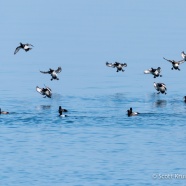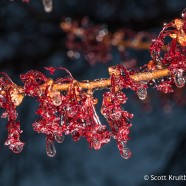Scaup Surge
Thanks to recent warm temperatures and favorable winds, Greater Scaup (Aythya marila) like those shown here are now on the move back to the north, and during the past couple of weeks their numbers have been growing across the region. While you can find some throughout the winter in open areas on large bodies of water such as Lake Erie, most members of this species migrate south to evade the cold. We have been able to enjoy several thousand – probably 5,000 or 6,000 and maybe more – in the waters of Long Island Sound off Stratford Point. Most stay rather far offshore and away from...
Read MoreHave a Drink
It is getting tough to find a drink out there in the frozen tundra. If you have any heated bird baths or ponds near your home you may end up with far more than songbirds stopping by! Consider setting something up in your yard to see what wildlife you may assist during these difficult months.
Read MoreIced Maple
These maple tree buds had a good coating of freezing rain covering them up in ice, too – I cannot imagine this is good for the trees or the wildlife that depends on them! But it was probably not as bad as the prolonged sub-freezing temperatures of the last couple of days… Scott Kruitbosch Conservation & Outreach Coordinator
Read MoreGreater Scaup
There were so many more ducks pushed out into the open ocean during the past two winters with the icy Great Lakes and nearly every inland body of water being locked up for most of the season in the Northeast. This year species like these Greater Scaup can still be found in more northerly areas with sometimes historic warmth occurring. As of yesterday the Great Lakes ice cover was only at 7.2% compared to 2015’s 49.0% and the even more frozen 77.7% in 2014. Our local Lake Erie was essentially entirely ice at this point in the last two winters because it is so shallow, measuring at 94.5%...
Read MoreNorthern Flicker
Here is the species that started everything for Roger Tory Peterson – the Northern Flicker. It and all birds came to represent to Roger all the freedom, beauty and vitality of the natural world. This Northern Flicker is a male as you can see by the black mustache. The bird is feeding on the ground, as many flickers do, searching for ants, beetles and other insect life. This winter is a good example of how a warmer than usual stretch of weather can impact a certain species as these strongly migratory birds might not have to fly so far to find uncovered, unfrozen earth. Climate change...
Read More








